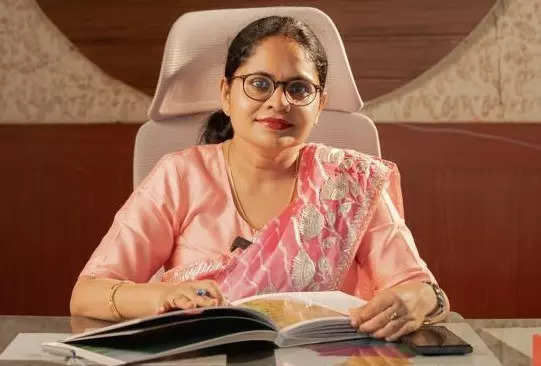
Pratapgarh is leveraging its rich cultural heritage and natural resources for sustainable development. The district is focusing on ecotourism, modern agriculture,and industrial growth.
Technology-driven governance reforms have improved transparency, public services, and grievance redressal, making administration more citizen-friendly. Women’s empowerment, artisan promotion, and long-term economic planning under Vision 2047 aim to enhance livelihoods and drive overall prosperity in the district.
This was stated by Anjali Rajoria, Collector & District Magistrate, Pratapgarh (Rajasthan), in conversation with ETGovernment’s Yagrica Repswal.
Edited excerpts:
Pratapgarh has a rich cultural and agricultural heritage. What initiatives are being undertaken to drive sustainable development and improve the quality of life?
Pratapgarh, a tribal sub-plan district, holds immense potential due to its rich cultural heritage and abundant natural resources. With 43% of its land covered by forests, the district administration is prioritizing ecotourism as a key driver of sustainable economic growth. While agriculture and animal husbandry remain primary occupations, modern farming techniques and high-yield seeds are being introduced to enhance productivity. As part of our Vision 2047, we are working to attract industrial investments and expand the service sector. By supporting ecotourism, improving agriculture, and growing industries, the district aims to create more jobs and promote overall development.How is technology being used in Pratapgarh to improve transparency, public services, and infrastructure planning?
We have enhanced transparency by leveraging technology. We have introduced e-filing systems and online portals for seamless service delivery. Citizens can apply for schemes online, saving time and effort. To improve revenue accountability, we launched the Saanch App, ensuring all compulsory registerable documents are properly recorded. For grievance redressal, we conduct Janta Darbars, district vigilance meetings, and utilize the Sampark Portal and 181 call center, enabling residents to file complaints and provide feedback.Our district has resolved 99.8% of grievances—one of the highest in the state—with an 83% satisfaction rate in Sampark Grievance Redressal. Helpline numbers are displayed across offices, and WhatsApp groups further streamline issue resolution. Most services fall under the Right to Services Act, with a Citizen Charter ensuring accountability. These efforts have made governance more transparent, efficient, and citizen-friendly.
Pratapgarh is known for its Thewa art, glass-inlay jewelry, Jeeravan, Hing, and rich tribal culture. How is the administration supporting local artisans and promoting ecotourism in the region?
Pratapgarh is famous for Mandana art, a traditional folk art practiced by women using geru soil. As part of the Vocal for Local initiative under the Government of India’s Aspirational Block program, we are actively promoting this art. Women are being trained, and a batch of skilled artists has already started painting an entire revenue village, decorating every house with Mandana motifs. We are also introducing Mandana art in merchandise like bedsheets, pillow covers, garments, and table covers, helping women generate sustainable income while preserving their cultural heritage.
Similarly, Thewa art—an intricate gold ornamentation on glass—is a prized craft of Pratapgarh. It is globally recognized, with pieces displayed in the London Museum and the Governor’s House. As part of Panch Gaurav, a state initiative to promote five key district crafts, we support Thewa artists by providing training and exhibition platforms to showcase their artistry. These efforts help preserve and expand our rich cultural traditions.
Your podcast series features interviews with professionals from diverse fields to inspire and motivate others. What inspired you to start this initiative, and what impact do you hope to achieve through it?
I started this initiative to highlight the untold success stories of individuals who have worked exceptionally hard but haven’t had the platform to share their journeys. For Instance, an artist whose Mandana paintings are now displayed at the Governor’s House and the Rajasthan Dance Academy—her perseverance and talent needed recognition. Similarly, a young bowler from a humble background recently gained fame when Sachin Tendulkar and other top cricketers shared her bowling action. These stories of resilience and hard work are meant to inspire others in our community to chase their dreams
What key steps do you believe are essential to empower women and create more opportunities for their growth and leadership in society?
In the Tribal Sub-Plan (TSP) areas, women often face struggles due to social and cultural challenges, such as the practice of men marrying multiple times without legal divorce, which leaves women financially unstable. To address this issue, we have launched the Babul Ki Bitiya campaign. This initiative aims to empower women financially and socially by connecting them to self-help groups, helping them access government benefits like pensions, housing, and skill development, and supporting their education.
We also introduced Mission Navodiya, a program that trains women leaders from local Panchayats in self-defense and psychological counseling. These women then share their knowledge within their communities, fostering a culture of empowerment. By focusing on financial independence, education, and skill development, we are working to help women become more self-reliant, dignified, and equipped to build brighter futures for themselves and their communities.
What are your key areas of focus for bringing sustainable growth and prosperity to the district?
Our long-term vision aligns with the Prime Minister’s Viksit Bharat 2047 roadmap. To achieve sustainable economic growth, we have prepared a detailed Vision 2047 document focused on increasing per capita income and diversifying employment opportunities. Agriculture and horticulture, being the primary occupations, require modernization, and we are promoting advanced technologies to enhance productivity and farmer incomes.
Women’s development is a key focus area. We are aiming to bring financial independence through skill development, livelihood schemes, and better market access for crafts like Mandana art. Agriculture contributes nearly 50% to the economy, but we aim to reduce this by expanding the industrial and service sectors, particularly agro-based and renewable energy industries. We have signed MOUs with various industries and are working towards generating more employment in both public and private sectors. With a projected CAGR of 9%, we expect per capita income to increase fourfold by 2047, driving long-term prosperity.


